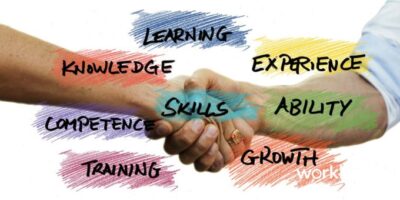It’s been a Timely week at Northern Essex Community College.
Mental Models
Sometimes an idea makes its way into popular opinion with very little evidence to support it—or even plenty of evidence to show it isn’t true—and it still takes a generation or more to shake it loose.
For example:
Don’t swim for at least thirty minutes after eating.
There is a grain of science behind this one: As you are eating, and for a while afterward, your body pumps extra blood into your digestive tract to aid in digestion. However, the amount “taken” from other parts of your body is not, as popular myth used to suggest, enough to prevent your arms and legs from pumping properly and keeping your head above the water.
Be sure to get yourself a “base tan” before going on vacation.
A number of scientific studies have proven conclusively that getting a “base tan,” especially in a tanning bed, does not prevent sunburns. In fact, any change in skin color from tanning is a sign of ultra violet radiation skin damage, and can lead to premature skin aging and cancer.
Vaccines cause autism.
Andrew Wakefield published a fraudulent article in The Lancet, a medical journal, in 1998 that created panic for parents around the world. Multiple studies conducted by the Centers for Disease Control and Prevention, the American Academy of Pediatrics, the UK National Health Service, and other major, reputable medical organizations clearly demonstrated the claims were untrue. The article was eventually retracted, and Wakefield was found guilty of serious professional misconduct and barred from practicing medicine. Yet nearly two decades later, concern about the safety of vaccines lingers.
If any of these surprised you, then you may also be interested to know that:
The Great Wall of China is not really visible from outer space.
At 5’-7”, Napolean was actually taller than the average Frenchman of his time.
George Washington did not have wooden teeth.
And…
Most college graduates in America are not unemployed and saddled with outrageous student loan debt.
Clearly, some of these myths and misconceptions are harmless. You can go on waiting a while after eating your sandwich before jumping in the pool; and you can hang onto the notion that General Washington crossed the Delaware with a mouthful of dentures made from the scrap wood of his rowboat and still lead a (relatively) normal life.
But others have consequences.
Skin cancer is the most common form of cancer in the United States, with 3.5 million cases diagnosed each year.
Measles had been eliminated in Great Britain, but during the Wakefield scare vaccination rates for children in some parts of England and Wales fell below fifty percent. Fifteen years later, a measles epidemic swept through Britain, with thousands of new cases diagnosed—mostly in children aged 10-18 who had not been vaccinated.
And if you scan the screaming headlines and tell your kids to skip college because it’s just not worth it, you are probably setting them up for a lifetime of difficulties.
It’s true: Despite climbing costs and a sometimes unpredictable job market, a college degree is still the surest path toward a stable middle-class life in America. Without one, you are more likely to be unemployed or underemployed, changing jobs frequently, without benefits such as paid vacation and sick time, dissatisfied with the work you are doing, and perhaps living in, or near, poverty.
But that’s not the way many Americans see it.
Just last week, I was talking about economic development strategies with a long-serving mayor of a Central Massachusetts city (not in the Merrimack Valley), and when our conversation turned to workforce education and training, he confidently declared that, “The problem is too many kids are going off to college and getting degrees in History and Philosophy—useless subjects. Then they’re unemployed and we have to support them. We don’t need everybody to go college. We need more electricians, welders, and machinists. And when people do go to college, they should study things that matter and will get them a job.”
I appreciated his candor—it’s always helpful to know just where someone is coming from—but winced at just how far off base he was, and at what that might mean for his community.
Yes, we do need workers in skilled trades and manufacturing, which is why NECC and community colleges across the country have been creating or expanding partnerships with vocational-technical high schools and employers in need of that kind of skilled labor.
But that’s only one piece of the puzzle, and there are still more jobs available for those with more education.
Unfortunately, that mayor is far from alone in carrying around his particular “mental model” of higher education in America today.
Quoctrung Bui, Graphics Editor for the New York Times, recently tried an experiment: Working with Google Consumer Surveys, he asked Americans, “What would you guess is the current unemployment rate for four-year college graduates between the ages of 25 and 34?”
The most common responses, shockingly but perhaps not surprisingly, were between 20-30 percent—way too high.
So, they provided some more background information and asked the question again, a little bit differently. The second time around they posed, “The unemployment rate for 24-to-34-year-olds without a four-year college degree is 7 percent. What do you think it is for 25-to-34-year-olds with a four-year college degree?”
More than half the respondents still thought the unemployment rate for college graduates was actually higher than the unemployment rate for those without a four-year degree.
The real unemployment rate for those with a college education?
Only 2.4%.
Which is not unusual. As Bui noted in the report on his experiment, “Since 2000, young college graduates, on average, have an unemployment rate that is 5.5 percentage points lower than those of nongraduates. And this gap typically widens during recessions; it expanded to 10 percentage points at the depths of the Great Recession.”
So, through good economies and bad ones, you are still better off with a college degree.
Still not sure?
If you would like to read more about the reasons why in great depth, I suggest taking a look at The Rising Cost of Not Going to College, a 2014 report from the Pew Research Center; Are Recent College Graduates Finding Good Jobs?, a 2014 study by the New York Federal Reserve Bank; and Underemployment in the Early Careers of College Graduates Following the Great Recession , a 2015 update to Fed’s previous study.
Or if you’re just interested in the highlights, here you go:
From The Rising Cost of Not Going to College:
- On virtually every measure of economic well-being and career attainment—from personal earnings to job satisfaction to the share employed full time—young college graduates are outperforming their peers with less education.
- Millennial college graduates ages 25 to 32 who are working full time earn more annually—about $17,500 more—than employed young adults holding only a high school diploma. (That grows to between $500,000 – $1 million more in earnings over a lifetime.)
- College-educated Millennials also are more likely to be employed full time than their less-educated counterparts (89% vs. 82%) and significantly less likely to be unemployed (3.8% vs. 12.2%).
- Millennial college graduates are more likely than their peers with a high school diploma or less education to say their job is a career or a steppingstone to a career (86% vs. 57%). In contrast, Millennials with a high school diploma or less are about three times as likely as college graduates to say their work is “just a job to get [them] by” (42% vs. 14%).
- In 1979 when the first wave of Baby Boomers were the same age that Millennials are today, the typical high school graduate earned about three-quarters (77%) of what a college graduate made. Today, Millennials with only a high school diploma earn 62% of what the typical college graduate earns.
- Among those ages 25 to 32, fully 22% with only a high school diploma are living in poverty, compared with 6% of today’s college-educated young adults. In contrast, only 7% of Baby Boomers who had only a high school diploma were in poverty in 1979 when they were in their late 20s and early 30s.
- While earnings of those with a college degree rose, the typical high school graduate’s earnings fell by more than $3,000, from $31,384 in 1965 to $28,000 in 2013.
From Are Recent College Graduates Finding Good Jobs? and Underemployment in the Early Careers of College Graduates Following the Great Recession:
- The “underemployment rate” for recent college graduates (that is, the rate at which those grads are working in jobs that do not actually require a degree) is always higher than for college graduates as a whole. Back in 1990-91, the rate was 46 percent. By 2001, after the economic boom times of the 1990’s it fell to 34 percent. Now, after a couple of recessions in the early 2000’s, it has climbed back up to 44 percent. (Not where we want to be, but also not unusual.)
- The percentage of recent college graduates in “low wage jobs” (jobs such as bartender, food server, and cashier that paid below $25,000 in 2012) increased from about 15 percent in 1990 to around 20 percent in 2009; while the share of all college graduates working in low wage jobs increased only modestly, from 13 percent to 15 percent.
- Looking at college majors and their employability, the two majors with the lowest unemployment rates are health majors, at 3 percent, and education majors, at just under 4 percent. While at the other end of the spectrum, the unemployment rate for architecture and construction majors was 8 percent—a finding consistent with the lack of jobs in housing-related sectors of the economy following the housing bust. Liberal arts and social sciences majors also tended to have relatively high unemployment rates, at 7 to 8 percent. (Note: That was back in 2012—those percentages have all fallen even lower since then.)
- Not all majors are feasible for every college student, and graduates with different majors often differ in other important ways that we are unable to measure, such as intelligence, perseverance, or motivation.
For those more visually oriented, this table from the U.S. Department of Labor nicely sums up how more education leads to higher earnings and greater chances for employment:

So, what should an aspiring college student (and his or her family) make of all this?
At the risk of oversimplifying, here is some straightforward advice:
- Some education and training beyond high school is better than no education and training beyond high school.
- For the overwhelming majority of people, having a college degree is a big advantage over not having a college degree.
- Choose a college you can afford. There are plenty of options available, including community colleges and state universities, that will not require you to take on huge amounts of debt. And believe it or not, for most people, the name of the college on your degree means far less in the marketplace than the degree itself. Be responsible for making a wise financial choice.
- As the old saying goes, “Do what you love, and you will never work a day in your life.” Yes, some majors such as engineering or nursing will practically guarantee you a good-paying job right out of college (at least this year they will—that could change.) But if you don’t enjoy those jobs, or if you are not academically equipped to pursue those majors, then they are not for you—find something else.
- Most people do not land their dream job right out of college. It often takes a few years of “paying dues,” networking, and climbing the ladder; but the majority of college grads (regardless of their major) do get there—typically by their late 20’s.
Former President George W. Bush his former Secretary of Defense, Robert Gates have history degrees.
Former presidential candidate and CEO of Hewlett-Packard, Carly Fiorina, and former Secretary of Education turned political pundit William Bennett have philosophy degrees.
Howard Schultz, CEO of Starbucks majored in Communications; Andrea Jung, former CEO of Avon has a degree in English Literature; and Michael Eisner, former Disney Company CEO double-majored in English Lit and Theater.
And that mayor who thought most people shouldn’t go to college, or should only major in STEM fields and healthcare? He has a degree in Criminal Justice, the field that the New York Federal Reserve determined is most likely to be “underemployed” out of all college majors (slightly nudging out “Performing Arts” and “Leisure and Hospitality”).
He has done very well for himself—and so can you.
Time Flies
Some people view time as a tool and a commitment. By sorting life into minutes, hours, days, weeks, and years, the world around us makes sense, we get things done, and we’re never late for dinner. You can easily tell who we are. We usually arrive at appointments a few minutes early, and many of us still wear a watch.
Others view time as more of a curiosity and a nuisance. Those minutes, hours, days, weeks, and years are flowing past, and once in a while they will dip their toe in the stream. They are perpetually running behind or late, and have never owned a watch.
When it comes to her particular mental model of time, Big Sis T has been what you might generously call “flexible.”
Until recently, she liked to think she could wake up at 7:00 and be at school (dressed, fed, and lunch packed) by 7:20. She would estimate her evening homework as “about an hour’s worth” of reading and writing—then find herself still scribbling notes in the margins long after the rest of the house was asleep. And I would usually find out about one of her friend’s birthday parties an hour or so before it began, when T asked for a ride to the event (and, by the way, could we stop at the store and pick up a present?)
Day planners or electronic calendars? Only for the time-obsessed, or the aging and slightly daft (like her Dad).
Then came the Summer of 2016.
I give Big Sis a lot of credit for the past few months. She took on her first “real” job at Dunkin’ Donuts, pouring coffee, running the drive-through cash register, and mopping floors (I reassured her that everyone should work fast food at least once in their lives). She also took weekly shifts at the YWCA day care, taught and took music lessons, played a few gigs, and completed an online Philosophy course that started the last week of her sophomore year. No rest for the weary!
But there were some pretty big early bumps along the way.
After forgetting which job she was supposed to be going to a couple of times, missing out on some planned vacation days, and cramming a lot of reading into fifteen minute breaks between pouring lattes and making Munchkins, Big Sis T finally declared she was ready to learn about Time Management (ugh!)
Thankfully, the tools she needed were right there at her fingertips. Actually, they were on her iPhone, which is more or less an extension of her fingertips.
So in early July we sat down and loaded into her electronic calendar all of the things that could be loaded in—work schedules, music lessons, vacation days, due dates for papers, birthday parties, and more, complete with politely chiming reminders to keep her on track.
Within a few days, she had become used to actually listening to those reminders, and checking her calendar before committing to something new. She was on time for all of her jobs, and a little ahead of schedule (or so she said anyway) in her online class. The whole house breathed a little easier.
Last week, she even grudgingly admitted that planning ahead wasn’t just for overachieving Type A personalities. High school student musicians can benefit from it, too.
But, she informed me, she would still be sleeping in as long as possible when school starts up again next week.
Deal.
As you look back on your week, and forward to the one ahead, may you do what you love, invest wisely in your future, and make the best use of your seven days, 168 hours, or 10,080 minutes.
And if you’d like to learn more about what’s been happening at NECC, please:
Visit the NECC Newsroom
Find me at www.facebook.com/lane.a.glenn
Or on LinkedIn
–Lane






